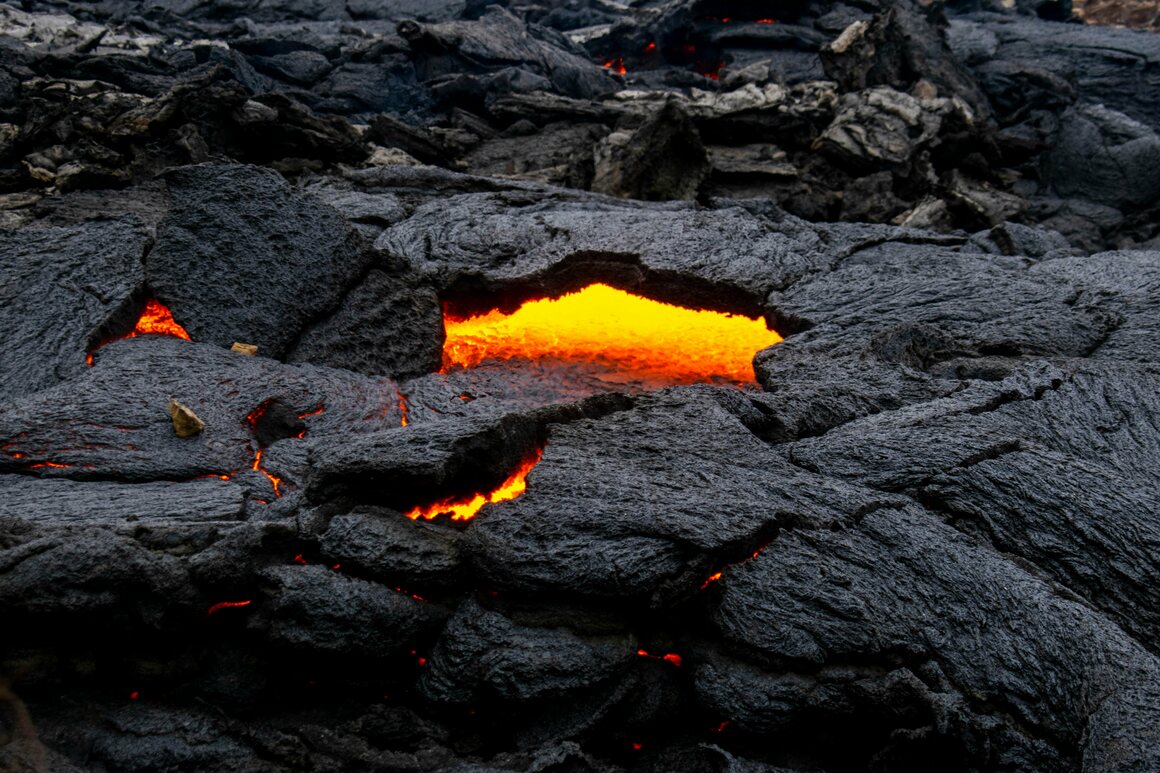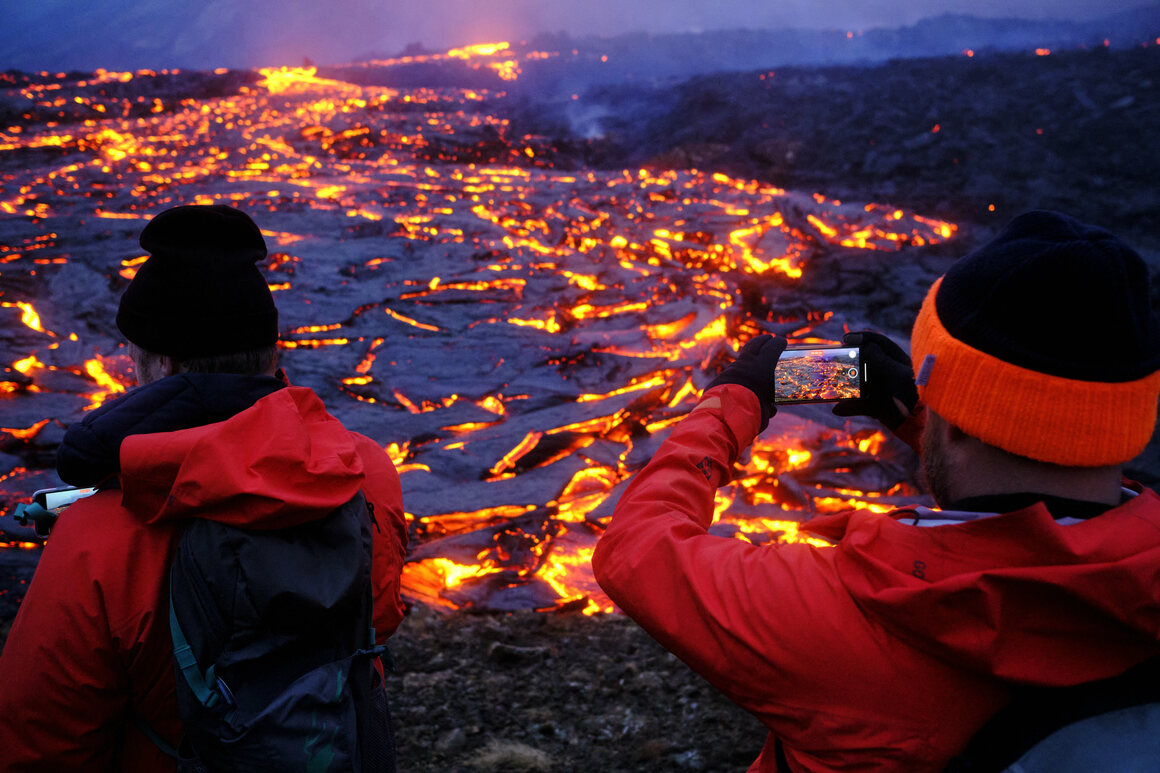Why Does Iceland’s Fagradalsfjall Volcano Look Like a School Science Project?
To many people around the world, the all-but-certain prospect of a new volcanic eruption on Iceland’s Reykjanes Peninsula sounded ominous. But in March 2021, when lava rushed out of a fissure in a valley named Geldingadalur—a comfortable six miles away from the nearest town, Grindavík—those in Iceland were nothing but thrilled.
The public was exhilarated to be able to see an eruption up close—one that posed little danger. Drone pilots flew their contraptions over rivers of molten rock like X-wing pilots. Scientists began forensically studying this once-per-millennium event, which is giving them a window into the part of the country that is quite literally being ripped apart by titanic tectonic forces.
It’s the best-case scenario for an eruption anywhere. Everybody’s a winner. And because the volcano, known as Fagradalsfjall, looks an awful lot like a school science project come to scorching life, this constantly documented eruption is a great opportunity to explain some of the fundamental features of this sort of miniature magmatic mountain.

If you have a peek at the live webcam footage of the eruption, you’ll be greeted with an astounding sight. On the night of March 19, the meandering curtain of lava oozing out of a 1,650-foot-long crack in the Earth became a much more focused affair. Molten rock began gurgling and leaping out of a kind of broken cauldron. At night, the basilica of fire is illuminated by its own radiant streams, as it gives the lava valley a long-overdue fresh coat of Hadean paint.
The tall structure is called a spatter cone. As is common with fissure eruptions, the magma below finds a path of least resistance and begins to gush onto the surface. As it does so, the lava spilling out around it begins to cool and solidify, forming a sort of ring. Blobs of lava—that’s the spatter—splash onto the ring of rock over time, eventually forming a cone that looks like a fun-size volcano.
Spatter cones can sometimes reach impressive heights quickly. Back during the 2018 eruption sequence at Hawaiʻi’s Kīlauea volcano, a cone at fissure number eight (of two dozen) grew to 180 feet tall. The cone and fissure have since been named Ahuʻailāʻau, after a volcano deity’s altar. If this Icelandic cone survives its own eruption, maybe it will get a name, too.

The construction of spatter cones can be chaotic and haphazard, and this baby cone in Iceland is no exception. On March 21, one side of the cone collapsed, causing a small cascade of lava to spill across the valley. At press time, the cone had lava coming out of two separate exits, technically known as vents.
This lava sometimes takes the form of streams, where the lava is cooling slowly and flowing smoothly, referred to as pāhoehoe (thanks, Hawaiʻi!). When the lava keeps moving but gets bunched up a bit and cools more quickly, it rips itself apart and forms rubbly, jagged, thicker flows that scientists call ʻaʻā.
The lava’s surface cools quickly on contact with air, forming that distinctive black crust, but you can spy little patches of red here and there. These are skylights, windows into the still-molten rock just below. If this unstable rocky roof collapses, you can sometimes get erratically spreading lava puddles.

Whatever form it takes, this lava is hot. Very hot. You don’t need an infrared camera to see that. And its color is an indication of that heat—from scarlet to clementine, corresponding to roughly 1,450 to 1,850 degrees Fahrenheit. It’s far too hot for a decent barbecue; any food you put on it will burst into flames or get crushed before melting. Best to wait for the lava to cool into a rock that, while still hot, is actually not a bad way to grill sausages, if you’re exceedingly careful.
That eruption temperature is typical of this flavor of lava, which is known as a basalt, and that type explains a lot about the sort of eruption we’re seeing. Magmas (lava when it’s still underground) often have a decent amount of silica in them, molecules that forms a sort of skeleton through the hellish soup that keeps it bound together, sort of like the proteins in an egg white. Lavas with relatively high concentrations of silica are thicker and more custard-like. If they have lots of gases dissolved in them while deep underground, they might suddenly, violently expand as the magma breaks through to the surface, creating explosions.
But basalt doesn’t have that much silica, so it is way runnier, more warm honey than custard. Consequently, its gases tend to bubble out fairly calmly, so unless it mingles with ice or a shallow body of water, which can trigger steam-driven blasts and make a lot of ash, big booms are much less likely.

Instead, what you may see from time to time are lava fountains, vertical streaks of molten rock forced into the sky by a collection of bubbles below, just like popping the cork on a shaken bottle of champagne. Gas bubbles formerly confined by pressure escape into a low-pressure environment, and as they rush outside they bring along the delicious champagne or less delicious lava.
The earlier stages of the Fagradalsfjall eruption were a bit gassier and had more oomph, so there were a number of small lava fountains. The ongoing eruption of Sicily’s Mount Etna has definitely trounced it in that department; at one point it was blasting its own basaltic lava into the clouds, with individual fountains reaching over twice the height of the world’s tallest skyscraper.
Unless you want to know what it feels like to be flambéed or hit by a superheated, fridge-sized cannonball, standing next to that Italian mountain’s spectacular summit eruption would be an all-around terrible thing to do. But the adorable paroxysm at Fagradalsfjall is so self-contained that the public—initially advised by the authorities to stay away, but now told the best place to stand—can just waltz on up to a nearby ridge and watch the youngest land on Earth being forged before their very eyes.

It isn’t a risk-free activity. It’s possible that another eruption could happen suddenly along another fissure in the area and, like the original crevasse opening, it wouldn’t provide much warning. The plume of gases that shoot out of the vents can be problematic, too. Much of it is water vapor, but there’s also sulfur dioxide, a gas that, even in small quantities, can dangerously aggravate the lungs of people with respiratory conditions such as asthma.
Overall, this eruption is relatively safe and approachable because, even with a runny sort of magma involved, most people can easily outwalk basaltic lava on a flat surface. By sitting uphill, you are placing a natural barrier between yourself and fiery doom. The greatest hazard there at the moment isn’t from fire, but from ice. Some onlookers have been parking their cars and then staying until nightfall—and then getting lost in a snowstorm while trying to leave.
No one is sure how long this eruption will persist. But the dimensions of the band of magma fueling it has been estimated from how the ground in the region has changed shape over the past month. It’s fairly thin, and is about four miles long, so presuming that modest amount of magma erupts in its entirety, the eruption might last a few more weeks.

But if more magma arrives from deep below, it could keep on going like this months or even years. It’s perfectly possible, at its current rate of production, that the lava could eventually fill up the valley. There’s no need to fret, because this valley is surrounded by other valleys like it. It would take a long, long time and a lot of lava to become a threat to any towns or people living on the peninsula.
There is a decent chance, though, that this eruption could mark the start of many decades, or even several centuries, of eruptions all across the peninsula, as has happened at least three times in the past few millennia. That this will take place on a sparsely populated strip of land is as ideal a volcanic situation you are going to get.
Like this youthful eruption we are all marveling at, a new era of widespread volcanic pyrotechnics on the Reykjanes Peninsula is something everyone could enjoy. It won’t merely reveal to scientists more about the enigmatic, magmatic engines that power this ever-shape-shifting country, but spectators, both in Iceland and elsewhere around the world, will gain a newfound appreciation for this dynamic, beautiful world: a pale blue dot flecked with fire.





